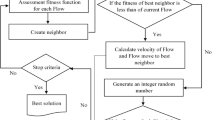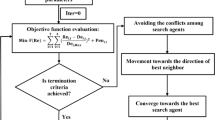Abstract
The optimal hydropower operation of reservoir systems is known as a complex nonlinear nonconvex optimization problem. This paper presents the application of invasive weed optimization (IWO) algorithm, which is a novel evolutionary algorithm inspired from colonizing weeds, for optimal operation of hydropower reservoir systems. The IWO algorithm is used to optimally solve the hydropower operation problems for both cases of single reservoir and multi reservoir systems, over short, medium and long term operation periods, and the results are compared with the existing results obtained by the two most commonly used evolutionary algorithms, namely, particle swam optimization (PSO) and genetic algorithm (GA). The results show that the IWO is more efficient and effective than PSO and GA for both single reservoir and multi reservoir hydropower operation problems.









Similar content being viewed by others
References
Afshar MH (2012) Large scale reservoir operation by constrained particle swarm optimization algorithms. J Hydro Environ Res 6(1):75–87
Afshar MH (2013a) Extension of the constrained particle swarm optimization algorithm to optimal operation of multi-reservoirs system. Int J Electr Power Energy Syst 51:71–81
Afshar MH (2013b) A cellular automata approach for the hydro-power operation of multi-reservoir systems. Proc ICE Water Manag 166(9):465–478
Afshar MH, Shahidi M (2009) Optimal solution of large-scale reservoir-operation problems: cellular-automata versus heuristic-search methods. Eng Optim 41(3):275–293
Afshar MH, Ketabchi H, Rasa E (2006) Elitist continuous ant colony optimization algorithm: application to reservoir operation problems. Int J Civ Eng 4(3):274–285
Afshar A, Massoumi F, Afshar A, Mariño MA (2015) State of the art review of ant colony optimization applications in water resource management. Water Resour Manag 29(11):3891–3904
Akbari-Alashti H, Bozorg-Haddad O, Fallah-Mehdipour E, Mariño MA (2014) Multi-reservoir real-time operation rule using fixed length gene genetic programming (FLGGP). Proc Inst Civ Eng Water Manage 167(10):561–576
Akbari-Alashti H, Bozorg-Haddad O, Mariño MA (2015) Application of fixed length gene genetic programming (FLGGP) in hydropower reservoir operation. Water Resour Manag 29(9):3357–3370
Allen RB, Bridgeman SG (1986) Dynamic programming in hydropower scheduling. J Water Resour Plan Manag 112(3):339–353
Arnold E, Tatjewski P, Wołochowicz P (1994) Two methods for large-scale nonlinear optimization and their comparison on a case study of hydropower optimization. J Optim Theory Appl 81(2):221–248
Asgari HR, Bozorg Haddad O, Pazoki M, Loáiciga HA (2015) Weed optimization algorithm for optimal reservoir operation. J Irrig Drain Eng:04015055
Barisal AK, Prusty RC (2015) Large scale economic dispatch of power systems using oppositional invasive weed optimization. Appl Soft Comput 29:122–137
Bozorg-Haddad O, Afshar A, Mariño MA (2006) Honey-bees mating optimization (HBMO) algorithm: a new heuristic approach for water resources optimization. Water Resour Manag 20(5):661–680
Bozorg-Haddad O, Afshar A, Mariño MA (2011) Multireservoir optimization in discrete and continuous domains. Proc Inst Civ Eng Water Manage 164(2):57–72
Bozorg-Haddad O, Karimirad I, Seifollahi-Aghmiuni S, Loáiciga HA (2015a) Development and application of the bat algorithm for optimizing the operation of reservoir systems. J Water Resour Plan Manag 141(8). doi:10.1061/(ASCE)WR.1943-5452.0000498.04014097
Bozorg-Haddad O, Moravej M, Loáiciga HA (2015b) Application of the water cycle algorithm to the optimal operation of reservoir systems. J Irrig Drain Eng 141(5). doi:10.1061/(ASCE)IR.1943-4774.0000832.04014064
Bozorg-Haddad O, Hosseini-Moghari SM, Loáiciga HA (2016) Biogeography-based optimization algorithm for optimal operation of reservoir systems. J Water Resour Plan Manag 142(1). doi:10.1061/(ASCE)WR.1943-5452.0000558.04015034
Chowdhury A, Bose S, Das S (2011) Automatic clustering based on invasive weed optimization algorithm. In: Swarm, evolutionary, and memetic computing. Springer Berlin, Heidelberg, pp. 105–112
Ellis JH, ReVelle CS (1988) A Separable linear algorithm for hydropower optimization. JAWRA 24:435–447
Esat V, Hall MJ (1994) Water resources system optimization using genetic algorithms. Hydroinformatics 94:225–231
Fallah-Mehdipour E, Bozorg-Haddad O, Mariño MA (2013) Developing reservoir operational decision rule by genetic programming. J Hydroinf 15(1):103–119
Garousi-Nejad I, Bozorg-Haddad O, Loáiciga HA (2016a) Modified firefly algorithm for solving multireservoir operation in continuous and discrete domains. J Water Resour Plan Manag. doi:10.1061/(ASCE)WR.1943-5452.0000644
Garousi-Nejad I, Bozorg-Haddad O, Loáiciga HA, Mariño MA (2016b) Application of the firefly algorithm to optimal operation of reservoirs with the purpose of irrigation supply and hydropower production. J Irrig Drain Eng. doi:10.1061/(ASCE)IR.1943-4774.0001064
Ghasemi M, Ghavidel S, Akbari E, Vahed AA (2014) Solving non-linear, non-smooth and non-convex optimal power flow problems using chaotic invasive weed optimization algorithms based on chaos. Energy 73:340–353
Goharian E, Burian S, Bardsley T, Strong C (2015) Incorporating potential severity into vulnerability assessment of water supply systems under climate change conditions. J Water Resour Plan Manag 142(2). doi:10.1061/(ASCE)WR.1943-5452.0000579.04015051
Jothiprakash V, Shanthi G (2006) Single reservoir operating policies using genetic algorithm. Water Resour Manag 20(6):917–929
Kangrang A, Compliew S, Hormwichian R (2010) Optimal reservoir rule curves using simulated annealing. Proc ICE Water Manag 164(1):27–34
Karamouz M, Goharian E, Nazif S (2013) Reliability assessment of the water supply systems under uncertain future extreme climate conditions. Earth Interact 17(20):1–27. doi:10.1175/2012EI000503.1
Karimkashi S, Kishk A (2010) Invasive weed optimization and its features in electromagnetics. IEEE Trans Antennas Propag 58(4):1269–1278
Larson RE (1968) State increment dynamic programming. American Elsevier, New York
Li C, Zhou J, Ouyang S, Ding X, Chen L (2014) Improved decomposition–coordination and discrete differential dynamic programming for optimization of large-scale hydropower system. Energy Convers Manag 84:363–373
Louati MH, Benabdallah S, Lebdi F, Milutin D (2011) Application of a genetic algorithm for the optimization of a complex reservoir system in Tunisia. Water Resour Manag 25(10):2387–2404
Mehrabian AR, Lucas C (2006) A novel numerical optimization algorithm inspired from weed colonization. Ecol Inform 1(4):355–366
Ming B, Chang JX, Huang Q, Wang YM, Huang SZ (2015) Optimal operation of multi-reservoir system based-on cuckoo search algorithm. Water Resour Manag 29(15):5671–5687
Moosavian SAA, Ghaffari A, Salimi A (2010) Sequential quadratic programming and analytic hierarchy process for nonlinear multiobjective optimization of a hydropower network. Optim Contr Appl Meth 31(4):351–364
Oliveira R, Loucks DP (1997) Operating rules for multireservoir systems. Water Resour Res 33(4):839–852
Roy GG, Das S, Chakraborty P, Suganthan PN (2011) Design of non-uniform circular antenna arrays using a modified invasive weed optimization algorithm. IEEE Trans Antennas Propag 59(1):110–118
Saravanan B, Vasudevan ER, Kothari DP (2014) Unit commitment problem solution using invasive weed optimization algorithm. Int J Electr Power Energy Syst 55:21–28
Teegavarapu RS, Simonovic SP (2002) Optimal operation of reservoir systems using simulated annealing. Water Resour Manag 16(5):401–428
Tospornsampan J, Kita I, Ishii M, Kitamura Y (2005) Optimization of a multiple reservoir system using a simulated annealing--a case study in the Mae Klong system, Thailand. Paddy Water Environ 3(3):137–147
Wu JK, Guo ZZ, Qin LH, Ning L (2009) Successive linear programming based optimal scheduling of cascade hydropower station [J].Power System Technology, 8, 006
Yoo JH (2009) Maximization of hydropower generation through the application of a linear programming model. J Hydrol 376(1):182–187
York C, Goharian E, Burian S (2015) Impacts of large-scale Stormwater green infrastructure implementation and climate variability on receiving water response in the salt Lake City area. Am J Environ Sci 11(4):278–292. doi:10.3844/ajessp.2015.278.292
Zambelli MS, Luna I, Soares S (2009) Long-Term hydropower scheduling based on deterministic nonlinear optimization and annual inflow forecasting models. In PowerTech, 2009 I.E. Bucharest (pp. 1–8). IEEE
Zhang R, Zhou J, Ouyang S, Wang X, Zhang H (2013) Optimal operation of multi-reservoir system by multi-elite guide particle swarm optimization. Int J Electr Power Energy Syst 48:58–68
Zhao T, Zhao J, Yang D (2012) Improved dynamic programming for hydropower reservoir operation. J Water Resour Plan Manag 140(3):365–374
Author information
Authors and Affiliations
Corresponding author
Rights and permissions
About this article
Cite this article
Azizipour, M., Ghalenoei, V., Afshar, M.H. et al. Optimal Operation of Hydropower Reservoir Systems Using Weed Optimization Algorithm. Water Resour Manage 30, 3995–4009 (2016). https://doi.org/10.1007/s11269-016-1407-6
Received:
Accepted:
Published:
Issue Date:
DOI: https://doi.org/10.1007/s11269-016-1407-6




